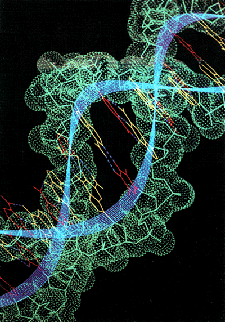The genetic alphabet performs a parity check like the computerized code. This is according to a study published on September 18 in the journal Nature

Natural selection chose the chemical bases of the genetic information, mainly because they are the best materials available to ensure the correct reading and copying of the genetic information.
Donal McDonnell of Trinity College Dublin discovered that the DNA code is like the match code that computerized information systems use to minimize the chance of making mistakes.
The genetic information stored in DNA is constantly read and replicated within living cells and it builds new protein molecules to carry out some of the cell's activities. This information is also copied into a new set of DNA when the cell divides.
A sequence of misreading or miscopying information can be disastrous. Dysfunctional genes cause diseases and defects. Errors can sometimes have positive effects - they create mutations that can drive the evolutionary process - but more often, the errors are fatal.
Thus the cells engage molecular machinery to check the reading or copying. This reduces the chance of mistakes, but does not completely prevent them. According to McDonnell, there is another mechanism for detecting errors - in the chemistry of the DNA itself.
The DNA double helix consists of two strands bent together and linked by hydrogen bonds. The four building blocks of each helix are called nucleotides. Their names are adenine, thymine, cytosine and guanine, known by the first letter of each of them A, C, T and G.
These four bases do not line up randomly but A sticks to T and vice versa and C sticks to G and vice versa. A is bonded to T through two hydrogen bonds and C is bonded to G through three. Other pairings are possible but they spoil the coil. Error-correcting enzymes look for such mistakes when DNA replicates.
This phenomenon was known until now, of course, but according to McDonnell, the meaning of these pairings is actually a code for detecting errors. Each hydrogen bond has two components - chemical groups called donors and acceptors. If we consider donor as 1 and acceptor as zero, then C encodes the pattern 100 and G the pattern 011.
In other words, each nucleotide can be represented as a short series of binary code like the 1's and 0's used to store information in computers.
There is another component to this code. A and G belong to a class of molecules called purines, while T and C are pyrimidines. Each such pair includes one furine and one pyrimidine. If we treat purine as 0 and pyrimidine as 1, then C becomes 100,1 and G becomes 011,0.
When the picture is presented this way, McDonnell says, the allowed combinations of A, C, T, and G refer to what computer scientists would call a parity code. Each nucleotide has an equal number of 1's, that is, of equal parity.
This facilitates the possibility of correcting errors such as locating unnatural nucleotides. If an error changes any digit in a nucleotide, its parity changes from even to odd. Unpaired nucleotides are explicitly incorrect.
When life emerged from simple molecular components, Donnell says, selective pressures would have favored a parity-coded alphabetic structure.
In other words, the genetic information encodes A,, T, C and G and not other types of purines and pyrimidines that must have coexisted with them in the same environment not by chance but as a result of the pairing code mechanism that characterizes this series of genetic building blocks. Other such combinations of similar molecules would produce other parity codes, but there are chemical reasons why these combinations could not work as well.
****
Another repair mechanism was discovered in the genetic material
Alex Doron, Maariv, 3/11/2002
Israeli scientists have discovered an intracellular mechanism, whose function is to correct defects in the genetic material. In a healthy person, this mechanism prevents the formation of genetic mutations, which lead to the development of diseases.
A study conducted by Prof. Zvi Livna, Head of the Department of Biological Chemistry at the Weizmann Institute, proved the existence of this unique mechanism and stated that every day the genetic material in the nuclei of living cells, the components of the human body, absorbs no less than 20 hits: radiation from the sun and contact with various substances . The injuries may disrupt the order of the components of the genetic material. Thanks to the repair mechanism - the repair of the damage is done with great precision. When there is a disruption in it - a risk arises, and a genetic mutation appears that causes a disease/disorder.
Until now, only one type of repair mechanism was known to exist. Now it turns out that there is another one, operating simultaneously with the first one - and in certain situations, in its place.
Prof. Birch: The discovered mechanism is based on a process known as "donation of genetic material". It takes place between the two strands of the double helix in the DNA molecules. When there is a break in one strand, and it stops working - the cellular repair mechanism comes into play. A process of mutual backup and contribution takes place between the strands, complementing each other in the event of a fault.
The importance of the research, the details of which were published in the journal "Molecular Cell", is that it will lead to the development of a new "weapon" in the fight against antibiotic-resistant bacteria. These bacteria have the ability to genetically change, to the resistant form.
